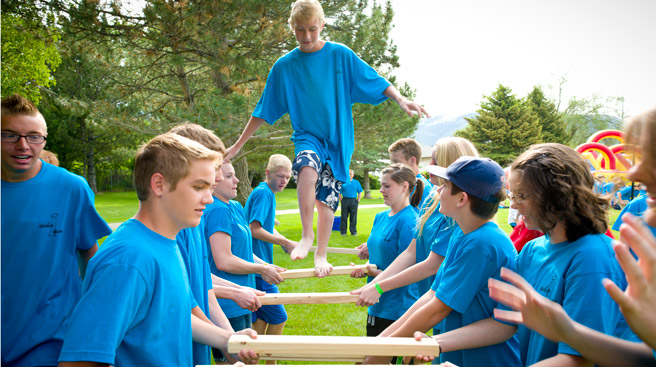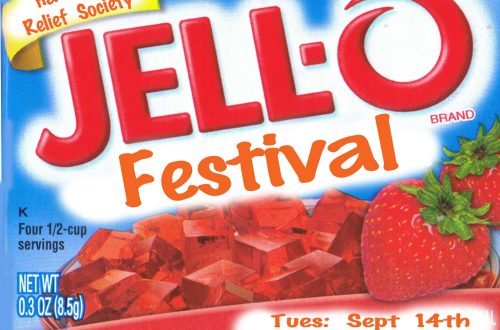
Youth Conference Activity Ideas – Steadfast and Immovable
Youth Conference Activities
Mosiah 5:15
Building Bridges
(Adapted from “Activities That Teach Family Values”, by Tom Jackson)
Materials:
One bag of miniature marshmallows, 100 toothpicks per team, one soup can per team, a ruler
Activity:
Divide into teams. Give each team about 75 marshmallows and 100 toothpicks. (Leave the marshmallows out of the bag for about an hour ahead of time, so they will harden slightly and be easier to work with.) Explain that the challenge is to build the longest, sturdiest bridge. It must be high enough off of the ground, for its entire length, that a soup can is able to pass underneath it the short way. In building the bridge, the teams may use as many toothpick supports as they wish as long as the soup can is still able to pass under the bridge. The bridge must also be at least one toothpick wide at the top. If a team runs out of marshmallows or toothpicks, you can allow them to get more.
Allow about 12 minutes for the teams to complete their bridges. However, for the first sixty seconds of their building time they cannot touch either the marshmallows or the toothpicks. During this time they are only allowed to talk about their plans for building the bridge. Count down the twelve minutes of building time for them as they work so they will know how much time they have left. When time is up, use a ruler to determine the winner.
Discussion Ideas:
Steadfast means firmly fixed, stable, unyielding, not subject to change.
1. Did any of the bridges fall? What worked best in making them firm/stable?
2. Did you use braces/supports? How did this help you to make the bridges longer?
3. When we have support/strength of the Gospel standards, can we be steadfast longer?
4. Why do bridges need to be sturdy/firm? Can we help others be steadfast? How can we carry others across?
Tall Towers
Materials:
Uncooked spaghetti, pipe cleaners, masking tape, empty cans, paper cups, paper
Activity:
Divide into teams. Give each team the same materials. The challenge is to use all of the materials to build the tallest freestanding tower. Points will be deducted for each object not used. Allow about 12 minutes. (Variation: try it with no talking!)
Discussion Ideas:
1. President Hinckley challenged us to “stand a little taller.” What does this mean?
2. How hard was it to keep the tower standing upright, the taller it got? What obstacles do we face as we strive to live the standards of the Gospel?
3. How does Satan try to tempt us more as we get stronger and closer to God? How does he try to make us yield? How can we remain immovable?
Helping Hands
(Adapted from “Activities That Teach Family Values”, by Tom Jackson)
Materials:
A jar of peanut butter, a jar of jelly, a table knife for each person, two pieces of bread per person
Activity:
Do this activity relay-style. Give the first person on each team one piece of bread and a table knife. Explain that their job is to make a peanut butter and jelly sandwich. There are two rules. First, they are to use only one slice of bread, so the sandwich is really only half a sandwich. You can’t just fold it over to make the sandwich. The piece of bread must be cut in half to form the two sides of the sandwich. Second, they can use only one hand. The other hand must be kept behind their back at all times. Now have them make the sandwich. When they are finished, the next person does it, and so forth.
After all team members have gone, you are ready for round two. Pair up into partners within teams. (If you have uneven numbers, use a leader.) Give each pair a new piece of bread. The challenge is the same: each person may use only one hand to create half a peanut butter sandwich, but the partners will now cooperate to make a sandwich. The winner is the team who finishes first.
Discussion Ideas:
1. What problems did you have when working by yourself? How did you feel during the first round? The second round?
2. Which sandwich looked better: the first one or the second one?
3. How did working together affect your efforts? Was it helpful to have a partner?
4. The first great commandment is to love God; the second is to love your neighbor. When we are helping others, we are serving. How can we lend a helping hand to others? How does it make you feel to serve? To be served?
Shake It Up
(Adapted from “Activities That Teach Family Values”, by Tom Jackson)
Materials:
Small container of heavy whipping cream per team, small glass jars with a lids, salt, rolls or unbuttered popcorn, table knife
Activity:
In this activity the youth are going to make butter. Begin by pouring the heavy whipping cream into the glass jar. Fill the jar about half full. You need to leave room for the cream to move as you shake the jar and to allow the cream to expand as it turns to butter. Now begin to shake the jar vigorously. Have everyone take turns shaking the jar. Allow each person to shake until his/her hand becomes tired. After 2-3 minutes, stop and open the jar up to see what changes have taken place. Then put the lid back on and resume shaking. Continue to open the jar up every 2-3 minutes to see what is happening. When almost all of the liquid cream has turned to a solid, you are done. Pour the slight amount of excess liquid out of the jar. Sprinkle a little salt in the jar. Put the lid back on and shake it a few more times to spread the salt evenly. Again pour off any excess liquid. Now get out some rolls or popcorn and enjoy the fruits of your labor.
Discussion Ideas:
1. How did spreading the work among more than one person help you make butter?
2. What are some challenges you face as youth? What can you do when you feel like giving up? Who can you turn to for help? How can you help others?
3. We are asked to be willing to bear each other’s burdens (Mosiah 18:8-9). How is that abounding in good works?
4. Is it more rewarding to enjoy the fruits of your labor alone or with others? Why?
Standing Firm
(Adapted from www.mormonshare.com)
Materials:
Stool, wooden sword, shield, good people
Activity:
Have one of the youth stand on a stool. Without warning, push him/her off. Since he was unprepared and not expecting it, he will most likely fall off. Have him get back on and then try to push him off again. This time he will probably not fall off, but will still be “movable.” Next, give him a “shield of faith” and a “sword of truth” as tools to defend himself. Now he will be nearly immovable. Finally, see what happens when you ask good friends, leaders, parents, Bishopric members, etc. to surround the youth on the stool. Now he is not only immovable, but you can’t even get close enough to try to push him off!
Discussion Ideas:
1. What happened when the youth was not prepared for opposition?
2. Was she more prepared the second time? Why was she still movable?
3. Read Ephesians 6:11-18. How does having the armor of God help us to be steadfast and immovable?
4. What happened when the youth had the support of good people surrounding her? How can it help us to surround ourselves with good people?
Final Discussion/Wrap-up:
1. Read Mosiah 5:15
2. What have you learned during this Youth Conference about being steadfast and immovable, always abounding in good works?
(Ideas: Joseph Smith’s example, how we can be like the early pioneers, tools we can use to help us, people that can help us, how we can abound in good works, and how that helps us stand strong)
3. Why is it important?
”…that Christ may seal you His…that ye may have everlasting salvation and eternal life…”





